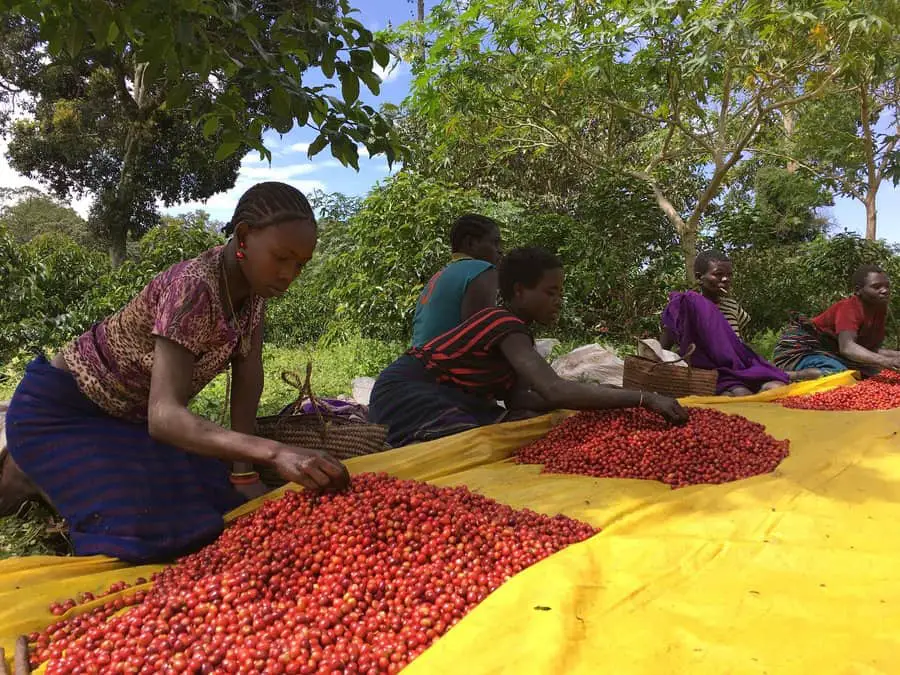
What is the C Market? The coffee commodity market, also known as the C Market, is where the global price of coffee is determined every single day by traders at the New York Stock Exchange.
Most of the time, when we’re brewing our morning cup of coffee or waiting impatiently in line at Starbucks, we never really stop to think about what coffee is worth.
Unless you’re a huge coffee enthusiast, or really into following the commodities market, you probably never even knew that coffee was a heavily-traded commodity, with a global export value totaling over $20 billion.
Although the NYSE might seem very far removed from your morning latte, the C Market actually has a huge impact on the price that you pay for your coffee.
In order to understand the C Market’s impact, it’s important to understand what commodities are in the first place. Basically, a commodity is a basic good (usually a raw material, like crude oil, or an agricultural product, like coffee). Every kind of commodity has specific quality standards.
Quality Standards For Green Coffee
The quality standards for coffee are pretty simple: the coffee beans need to be from the Arabica species, they need to be green (unroasted), they must have come from coffee farms in one of twenty predetermined coffee-producing nations, and the coffee exchange needs to take place in one of eight licensed warehouses around the globe.
If a pound of coffee conforms to these quality standards, then it can be traded on the C Market, and its value is deemed identical to all of the other pounds of coffee that have also met C Market quality standards.
However, although the value of any given pound of coffee on the C Market is always exactly the same as all of the other pounds of coffee on the C Market, this overall price varies from day to day. For example, on January 31, 2019, the price of one pound of coffee on the C Market was $1.06.
The next day, the price had dropped to $1.04. If you’re interested in following the daily shifts in C Market coffee price, you can look it up online using the stock symbol KCN9.
How is coffee traded
The price of coffee on the C Market doesn’t fluctuate randomly — it shifts based on supply and demand, but also based on trader predictions about future supply and demand.
Essentially, all of the actors on the C Market are either trying to buy coffee at cheap prices, or sell coffee at high prices. However, the actual nuances of the C Market aren’t quite this simple.
A lot of the activity on the C Market revolves around futures contracts. Futures contracts are agreements between buyers and sellers on the C Market (or on any commodities market).
In a C Market futures contract, a buyer agrees to purchase a specific quantity of coffee (usually 37,500 pounds) for a specific price at a specific time, which is designated by the future contract’s expiration date. Sometimes, this expiration date doesn’t happen until several years after the contract gets made.
The specific prices for futures contracts are determined based on the commodity market price at the time the contract gets made, which means that buyers are generally seeking to make futures contracts when the commodity price of coffee is low, ensuring that they don’t end up having to pay a lot more for their coffee if the price suddenly skyrockets.
The Coffee Consumer
Now that we’ve covered the basics of how the C Market works, it’s time to discuss how all of this affects you, the everyday consumer of coffee. Normal consumers don’t get their coffee from the C Market for a number of reasons.
Firstly, buyers and sellers on the C Market generally trade in massive quantities, with individual units of purchase weighing in at almost 20 US tons.
No single human being needs that much coffee! Secondly, as we mentioned earlier, the coffee that gets traded on the C Market hasn’t been roasted yet. Many of the buyers on the C Market are coffee roasting companies.
They purchase these massive quantities of coffee, roast them, and then distribute them to coffee shops and grocery stores, which is where the everyday consumer comes in.
As the commodity price of coffee increases, the consumer price tends to increase as well. And of course, as the commodity price of coffee decreases, the consumer price tends to decrease in turn.
Coffee Farmers and C Market

Although fluctuations in the C Market definitely do impact the casual coffee consumer, their effects are felt much more strongly among coffee farmers, who produce all of the coffee that gets traded on the C Market. 80% of the coffee that gets traded on the C Market is grown by small farms in nations like Brazil, Colombia, India, Mexico, Peru, Honduras, and Guatemala.
The farmers who own these small coffee-producing farms are very vulnerable to the upswings and downswings that happen from day to day on the C Market. The cost of growing coffee remains fairly consistent from year to year and from farm to farm, ranging between $1.05 and $1.40 per pound.
However, the commodity price of coffee on the C Market is generally lower, ranging from between $0.90 and $1.25. In fact, in early 2019, the price of a pound of coffee on the C Market dropped to its lowest point since 2006.
These increasingly low prices mean that many small coffee farmers are actually losing money when they sell their coffee on the C Market. Futures contracts on the C Market can also have a negative impact on small coffee farms.
For coffee buyers on the C Market, establishing futures contracts are a great business move — futures contracts allow them to obtain massive quantities of coffee, often for a lower price than the going C Market rate. On the flip side, this means that many small coffee farmers end up having to take even heavier of a loss when making deals with coffee buyers.
However, if they don’t agree to a futures contract, they’ll be stuck with tons and tons of green coffee beans, with absolutely no way to recoup any of the money they’ve sunk into coffee production.
Unfortunately, this predicament means that many of the laborers behind your morning cup of joe earn less than a living wage and live under the poverty line. If you’re interested in seeking out more ethically-sourced coffee, look for coffee shops and producers that exclusively use sustainable coffee.
Other Markets
Something else that complicates the C Market is that not all of the coffee that you drink is necessarily traded on the C Market. One of the problems with the coffee that gets traded on the C Market is that it is considered an undifferentiated good. Either the coffee meets basic quality standards and gets traded on the C Market, or it doesn’t.
However, there is a lot of subtle variation within the category of C Market-tradeable coffee. Depending on the environmental conditions in which a coffee plant is grown, which include soil, altitude, and rainfall, the flavor nuances of the coffee beans it produces can vary quite a bit. These different flavor varieties aren’t accounted for on the C Market.
A coffee bean grown at 3,000 feet in Mexico is valued exactly the same as a coffee bean grown at 4,500 feet in Costa Rica, even though the two beans likely have very different flavor profiles.
Of course, these flavor varieties matter a lot for coffee roasters, distributors, and consumers, even if they’re a non-factor on the C Market. This discrepancy between the quality standards of the C Market and the quality standards of the actual participants in the coffee industry has created a second coffee marketplace, the specialty coffee market.
In contrast to the C Market, which treats all of its coffee beans as identical in quality and value, the specialty coffee market takes into account the quality of different kinds of coffee beans when setting their prices.
Generally speaking, the coffee that gets traded on the specialty coffee market is more expensive than the coffee that gets traded on the C Market due to these differences in quality.
Sometimes, small coffee farmers are able to recover some of their losses on the C Market by selling higher-quality coffee on the specialty coffee market at a premium.
However, even when their profit from the specialty coffee market is factored in, many small coffee farms are still operating at a loss, or just barely breaking even.
Final Thoughts
Although we may not have cause to think about it in our day-to-day lives, the coffee that we drink is the end product of an incredibly complex set of markets.
Minute fluctuations in C Market and the specialty coffee market might seem insignificant, but they can and do impact the price that we as consumers pay for our coffee. More importantly, they also impact the livelihoods of the farmers who provide all of the coffee we love.

